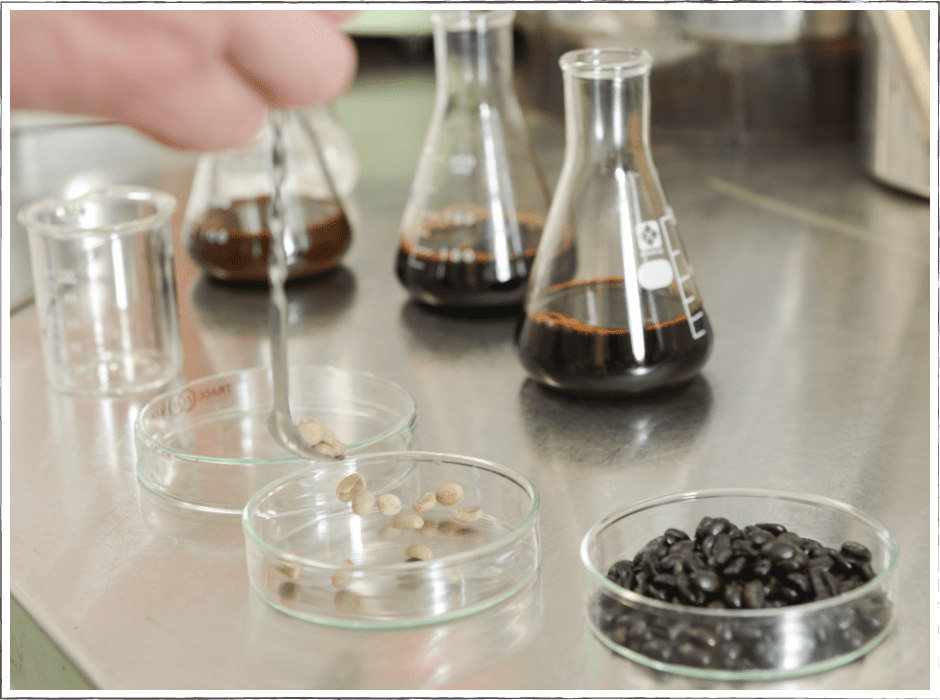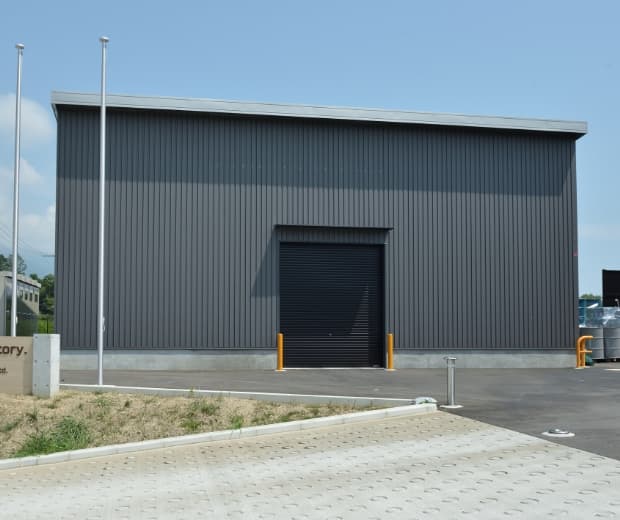Manufacturing technologies driven by four commitments
Small-lot production that lets us aggressively pursue flavor and aroma

The principal determinants of the deliciousness of coffee extract and coffee paste are flavor and aroma. HONEY COFFEE’s insistence on small-lot production is necessary to allow the fine-grained pursuit of delicious flavor and rich aroma. With extracts that use large-scale manufacturing equipment, large amounts of ingredients are added at the same time, making it difficult to fine-tune mixtures, while use of high pressures results in off-flavors and bitterness. Our small-lot production approach lets us fine-tune parameters like bean mixture and quantity, pressure, and temperature during work at our production site, allowing this work to proceed in a flexible and fine-grained manner. Moreover, our speedy manufacturing process takes place in just one day from the time ingredients are delivered. Since we’re able to produce products quickly using an inline system that prevents exposure to outside air, we can minimize oxidation and supply highly fresh products. HONEY COFFEE products earn customer praise for their balance of flavor, richness, and aroma, and because they’re pleasing to drink and easy to combine with other ingredients as processed products.
We manufacture four types of products using proprietary technology: extracts, flavors, oils, and pastes.

HONEY COFFEE manufactures four kinds of processed products—coffee extracts, coffee flavors, coffee oils, and coffee pastes—from individual beans using three types of extraction equipment. Our processed products, including extracts that are easy to process into final drink and food products and liquid flavors that dissolve smoothly and mix readily with target products, are easy to process. Our coffee flavors and coffee oils are used as essences that create new added value through secondary processing by drink and snack manufacturers. Moreover, our extracts and pastes are used by small and medium-size dairy, food, and snack manufacturers and other companies to add coffee flavor and aroma, and they’ve earned praise for their ability to mix readily with target products.
Our products are used by a broad range of customers, from large manufacturers to small and medium-size manufacturers and boutiques as food and drink ingredients for a range of needs and final products.
We create the ingredients customers are looking for through joint development.

HONEY COFFEE takes advantage of the strengths of its small-lot approach to production to custom-manufacture all its products. At the Lab at our Lake Biwa Factory, HONEY COFFEE staff and customers work together to jointly develop ingredients for coffee, tea, and other products. We can prototype the ingredients customers are looking for, for example flavors and aromas, right there at the site, allowing us to create original ingredients that align with customers’ visions while fine-tuning the particulars. Through this joint development process, we can help you develop appealing, original products by creating satisfying ingredients.
We practice exacting quality control through four quality inspections, right up to the final stage of product development.

We carry out four quality inspections right up to the shipping stage to check concentration (Brix value), pH level, amount of settling, specific gravity, and taste. These inspections, each of which is overseen by a different coordinator, occur at the following times: (1) after extraction, (2) after formulation, (3) before filling, and (4) after filling. Through this rigorous approach to quality control, we strive to provide a stable supply of products that satisfy product specifications.
(1) Concentration inspection: We produce each product at the concentration (Brix value) desired by the customer and manage concentration so that it doesn’t change, both after extraction and after formulation.
(2) pH level inspection: We manage pH level thoroughly so that we can deliver highly fresh products. We’ve put in place production structures to prevent oxidation so that pH levels remain within ±0.3 of the target value as part of a rigorous quality control system.
(3) Settling inspection: We check for settling by using a centrifuge to separate products into liquid and sediment components.
(4) Specific gravity inspection: We check proportionality between concentration and specific gravity according to the customer’s desires. We verify that formulations are characterized by a good balance between moisture content and coffee.
(5) Taste inspection: We verify that there is no difference in flavor from a reference product from the previous production run.
Manufacturing process

We have an extensive selection of proprietary equipment, including proprietary Honey oil presses, continuous column concentrators, and vacuum concentration aroma extractors. As a result, we can choose the best equipment for each extraction project based on the customer’s application, volume, and cost preferences.
Each unit manufactures two types of processed product, for example coffee oils and coffee flavors. Flavors extracted with these units have the richest, fullest-bodied aromas. Since all types of extraction are possible, for example using coffee beans, we can manufacture original oils that are restricted to particular production regions, for instance using only coffee beans from Brazil.

Our seven continuous column extractors can concentrate ingredients up to a factor of 30 times, making possible production of authentic, high-quality coffee extracts and natural coffee flavors. The flavors extracted using these machines have the aroma of freshly brewed coffee.

We have a total of 12 tanks in four sizes: 6,000 liters, 5,000 liters, 3,000 liters, and 2,000 liters. As a result, we can let freshly produced extracts rest for a day without any standby time elapsing first. We’ve added tanks to significantly boost work efficiency.


After using a centrifuge to remove sediment in each batch of liquid, we return it to the formulation tank and expose it to sterilization plates. Then we apply temperature in line with the product specifications to sterilize the liquid and use steam to sterilize the equipment. Contamination with foreign matter is prevented using filters and powerful magnets.

We’ve improved our filling processes as part of our FSSC 22000 compliance initiatives. Processed products are packed hygienically by means of sterile filling in a positive-pressure room fed with clean air.


We carry out painstaking inspections to ensure that products are free of any defects before shipment and that no anomalies have occurred during the manufacturing process.

After being inspected, products are shipped to customers’ facilities. Shipping and receiving bays have triple doors to keep dust and bacteria out of the factory, and shipping work is carried out under strict hygiene controls.

Other equipment
-
Pure water system

To prepare water for use in extraction, we take groundwater from Mt. Hiei, pass it through three filter systems, sterilize it with chlorine, and then purify it using a pure water system. Characteristics such as purity, residual chlorine concentration, and hardness are shown numerically on the system’s panel display, and an alarm sounds to alert workers in the event that reference values are exceeded.
-
Boilers

We’ve installed three state-of-the-art gas boilers in our boiler room and put in place structures to ensure a stable supply of heat. A boiler monitoring system ensures safety 24 hours a day.
-
Cooling system

This system cools extract and other liquids. Extract liquid is cooled as it circulates between multiple plates carrying chilled water and around the system’s cooling tank.
-
Chilled and cold storage

Our factory includes chilled and cold storage facilities, streamlining operations by allowing us to time ingredient orders and product shipments to accommodate our manufacturing schedule.
-
Groundwater storage tanks

Behind our factory, we store pumped, filtered groundwater. The tanks’ lids are locked to prevent unauthorized access.
Examples of Product Development
Example 1
Dairy industry manufacturer
Coffee extract

We realized an easy-to-process, delicious café au lait product without increasing cost.
When domestic dairy manufacturers produce carton-packaged or chilled-type café au lait products, they often use imported extracts and powders, but those ingredients are sometimes difficult to process in a way that makes it possible to achieve the type of flavor preferred by Japanese consumers. When a customer contacted us to ask whether we could help create an easy-to-process extract that could yield compelling, delicious flavor without necessitating a significant increase in the cost of coffee ingredients, our Lab worked with them to develop an original coffee extract. Being a dairy manufacturer, the customer wanted to create a café au lait product that evoked the delicious flavor of milk, so we created a series of prototypes that focused on extract concentration and striking just the right balance of flavor with the milk. While spending about a month to develop a coffee extract with the optimal balance, we also worked to create a delicious-looking texture and aroma when the product is poured into a cup. The customer was pleased with the result, praising how the liquid extract mixes readily with milk, resists precipitating out of solution, and yields improved flavor.
Example 2
Beverage manufacturers, restaurant chain operators, mass-retailers, etc.
Aromas for coffees, teas, etc.

We create premium feel with the rich aroma of coffee.
While many low-cost, good-quality products are being developed in the food industry, companies are also actively developing premium products, and we’re receiving requests from a variety of industry segments. A product can be transformed into a select, premium coffee that’s rich in aroma simply by adding coffee aroma to coffee extract. Ordinary aroma ingredients are made by mixing coffee extract with offerings manufactured at specialized plants, but we can develop products with short lead times while limiting costs because we can product both extracts and aromas at our own facility. Since aroma development can be used not only for coffees, but also for beverages like black tea and Japanese tea, we work together with customers in the development process to realize exactly the sort of premium feel they wish to achieve, from square one. Our products enjoy broad use in private-label products and other offerings from beverage manufacturers, restaurant operators, and mass-retailers.
Example 3
Small boutiques, for example bakeries producing cakes or breads
Original HONEY COFFEE extracts
We help small boutiques develop original products with exactly the flavors they’re looking for.
We continuously stock several varieties of original HONEY COFFEE extracts that differ in terms of characteristics like flavor, concentration, and degree of roasting so that boutiques like bakeries producing cakes or breads can use them in small lots. We’re happy to propose the right product that most closely approaches each customer’s desired flavor by offering multiple samples. Customers can produce original flavors by adding these extracts to cakes, breads, and other baked goods while resting easy in terms of cost and inventory management since they’re available in small lot sizes. Some customers use highly fresh extracts by purchasing one case each month in an ongoing arrangement.
Example 4
Seasoning manufacturers, soy sauce manufacturers, fruit growers, etc.
Citrus, floral, spice, and other aromas
Waste products can be used as fresh fragrances! Ponzu sauce with a striking citron aroma can be created through a change in value.
Aromas, which are produced by extracting fragrances from ingredients, can be used to impart foods and other products with those fragrances. Example uses of “edible” aromas include spraying aromatic liquids with fragrances like citron or lemon onto salads, adding aromas to sake to increase bouquet and texture, and using aromas to create delicious flavors. At the request of a ponzu sauce manufacturer, we developed a richly fragrant ponzu sauce using 100% natural ingredients by extracting aromas from the skin and remaining fruit of citron that had been pressed for its juice and then returning them to a bottle. In this way, waste products were transformed into fresh fragrances. As a bonus, use of the extracted aromas reduced moisture, decreased waste volume by half, and earned praise as an environmentally friendly approach.






